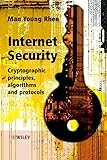Internet security : cryptographic principles, algorithms, and protocols / Man Young Rhee.
Material type: TextPublication details: Chichester, West Sussex, England ; Hoboken, NJ : J. Wiley, 2003.Description: xvii, 405 p. : ill. ; 26 cmISBN:
TextPublication details: Chichester, West Sussex, England ; Hoboken, NJ : J. Wiley, 2003.Description: xvii, 405 p. : ill. ; 26 cmISBN: - 0470852852 (alk. paper)
- 9780470852859
- 005.82 21
| Item type | Current library | Call number | Copy number | Status | Date due | Barcode | |
|---|---|---|---|---|---|---|---|
 Books
Books
|
Main library General Stacks | 005.82 RH.I / 2003 (Browse shelf(Opens below)) | 1 | Available | 003120 | ||
 Books
Books
|
Main library General Stacks | 005.82 RH.I / 2003 (Browse shelf(Opens below)) | 2 | Available | 003121 |
Browsing Main library shelves, Shelving location: General Stacks Close shelf browser (Hides shelf browser)

|

|

|

|

|

|

|
||
| 005.8 / XI.W 2007 Wireless network security / | 005.82 / MO.I 2007 Innovative cryptography / | 005.82 RH.I / 2003 Internet security : | 005.82 RH.I / 2003 Internet security : | 005.82 / WO.C 2007 Cryptology unlocked / | 005.82 YO.M / 2004 Malicious cryptography : | 006 / ST.N 2010 Networked graphics : |
Includes bibliographical references (p. [383]-390) and index.
Preface -- Internetworking and Layered Models -- TCP/IP Suite and Internet Stack Protocols -- Symmetric Block Ciphers -- Hash Function, Message Digest and Message Authentication Code -- Asymmetric Public-key Cryptosystems -- Public-key Infrastructure -- Network Layer Security -- Transport Layer Security: SSLv3 and TLSv1 -- Electronic Mail Security: PGP, S/MIME -- Internet Firewalls for Trusted Systems -- SET for E-commerce Transactions -- Acronyms -- Bibliography -- Index.
Knowledge of number theory and abstract algebra are pre-requisites for any engineer designing a secure internet-based system. However, most of the books currently available on the subject are aimed at practitioners who just want to know how the various tools available on the market work and what level of security they impart. These books traditionally deal with the science and mathematics only in so far as they are necessary to understand how the tools work. Internet Security differs by its assertion that cryptography is the single most important technology for securing the Internet. To quote one reviewer
"if every one of your communication partners were using a secure system based on encryption, viruses, worms and hackers would have a very hard time". This scenario does not reflect the reality of the Internet world as it currently stands. However, with security issues becoming more and more important internationally, engineers of the future will be required to design tougher, safer systems. Internet Security: * Offers an in-depth introduction to the relevant cryptographic principles, algorithms protocols - the nuts and bolts of creating a secure network * Links cryptographic principles to the technologies in use on the Internet, eg. PGP, S/MIME, IPsec, SSL TLS, Firewalls and SET (protecting credit card transactions) * Provides state-of-the-art analysis of the latest IETF standards plus summaries and explanations of RFC documents * Authored by a recognised expert in security Internet Security is the definitive text for graduate students on security and cryptography courses, and researchers in security and cryptography areas. It will prove to be invaluable to professionals engaged in the long-term development of secure systems.
1
There are no comments on this title.
